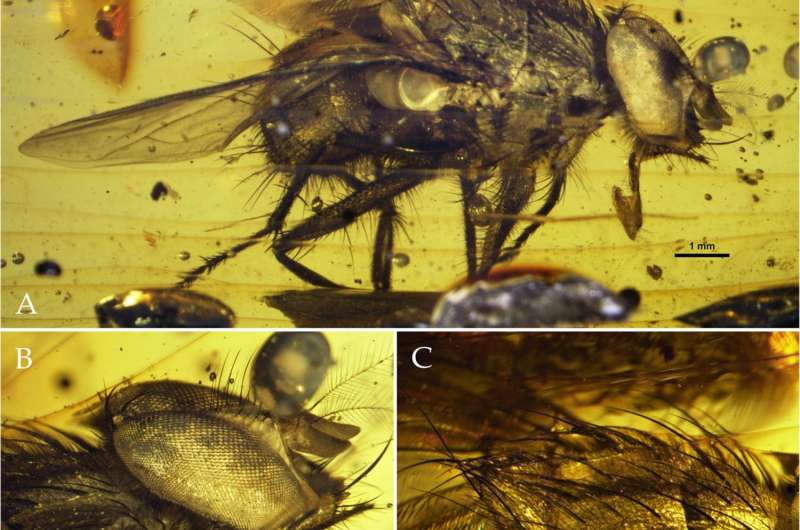New fly fossil sheds light on the explosive radiation of flies during the Cenozoic Era

The first unambiguous fossil from the botfly family adds to the few known fossils of a major clade of flies (Calyptratae), shedding light on their rapid radiation during the Cenozoic Era, according to a study published August 23, 2017 in the open-access journal PLOS ONE by Pierfilippo Cerrito from Sapienza Università di Roma, Italy, and colleagues.
The bot fly family (Oestroidea) is the most diverse group of calyptrate flies, which is a clade of some 22,000 living species that comprise about 14% all flies. Calyptrates arose during the Cenozoic, in what was the most rampant radiation of flies ever and among the largest radiations of insects during this era. The clade includes some of the most diverse and ecologically important families of flies: tsetse, louse, and bat flies; house flies and relatives; and blow flies, bot flies, flesh flies, and relatives. Abundant in most terrestrial ecosystems, calyptrates often play key roles as decomposers, parasites, parasitoids, vectors of pathogen vectors, and pollinators. However, there are few reliable calyptrate fossils.
Cerretti and colleagues describe the first unambiguous oestroid fossil: a new species of fly (Mesembrinella caenozoica) discovered in amber from the Dominican Republic. The researchers also used the few known calyptrate fossils as calibration points for a molecular phylogeny to estimate the timing of major radiations in this clade.
The researchers estimate that the most recent common ancestor of today's calyptrate flies lived about 70 million years ago—that is, just before the Cretaceous-Paleogene boundary; that the radiation of oestroids began about 50 million years ago; and that the family M. caenozoica belongs to (Mesembrinellidae) originated about 40 million years ago. Importantly, the Cretaceous-Paleogene extinction event played a role in major radiations of birds, mammals and angiosperms—and this work suggests that it may also have been crucial to boosting calyptrate diversification during the Cenozoic.
More information: Cerretti P, Stireman JO III, Pape T, O'Hara JE, Marinho MAT, Rognes K, et al. (2017) First fossil of an oestroid fly (Diptera: Calyptratae: Oestroidea) and the dating of oestroid divergences. PLoS ONE 12(8): e0182101. DOI: 10.1371/journal.pone.0182101
Journal information: PLoS ONE
Provided by Public Library of Science





















